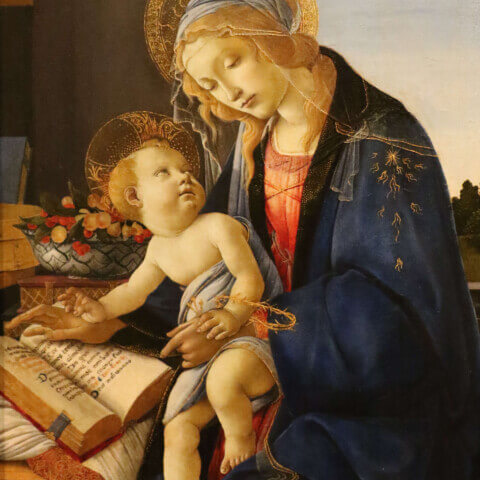Michelangelo Buonarroti’s The Creation of Adam is a defining work of the Italian Renaissance and one of the most famous frescoes ever created. Painted between 1511 and 1512, it adorns the ceiling of the Sistine Chapel in Vatican City, part of a vast narrative cycle commissioned by Pope Julius II. This fresco, situated among nine central panels depicting stories from the Book of Genesis, specifically portrays the divine act of giving life to the first man, Adam.
The Painting: An Icon of Creation
The composition of The Creation of Adam is a masterpiece of dramatic tension and symbolic resonance. God is depicted as a dynamic, muscular figure surrounded by angels and encased in a swirling, draped mantle. His outstretched arm conveys energy and intent as He reaches toward Adam. Adam lies reclined on the earth, his pose graceful but lifeless, awaiting the divine spark. The centerpiece of the fresco is the almost-touching hands of God and Adam, their fingers separated by a small but profound gap that holds immense symbolic weight. This space encapsulates the moment of creation, the anticipation of life, and the connection between the divine and human.
Michelangelo’s rendering of Adam is remarkable for its anatomical precision and idealized form. His body, a paragon of strength and beauty, reflects the Renaissance celebration of humanism, where man is seen as a reflection of divine perfection. The figures’ postures and gestures echo classical art traditions, linking Christian theology with Greco-Roman ideals.
Michelangelo’s Technique and Vision
The fresco demonstrates Michelangelo’s mastery of anatomy and his ability to imbue static images with motion and vitality. Trained initially as a sculptor, Michelangelo brought a sculptor’s understanding of three-dimensional form to his painting. His use of chiaroscuro (the contrast of light and shadow) gives depth and realism to the figures, while the bold colors enhance the visual impact of the scene.
Michelangelo worked on the Sistine Chapel ceiling under physically grueling conditions, lying on scaffolding and painting overhead. Despite his complaints about the difficulty of the task, he created a monumental work of art that transformed the chapel into a celestial vision.
Symbolism and Interpretation
The painting has been the subject of extensive analysis and interpretation. One of the most debated aspects is the shape of God’s mantle. Scholars and medical experts have noted its resemblance to a human brain, suggesting Michelangelo may have subtly depicted the brain to symbolize intellect as a divine gift. Others see the mantle as a womb, reinforcing themes of creation and life.
The hands of God and Adam, central to the composition, are among the most recognized images in art history. They have come to symbolize not just divine creation but also human potential, the relationship between the spiritual and the physical, and the fragility of existence.
Michelangelo: The Artist
Michelangelo (1475–1564) was one of the most celebrated artists of the Renaissance, excelling in painting, sculpture, architecture, and poetry. He was deeply influenced by classical antiquity and Christian theology, merging these influences into works that conveyed profound beauty and spiritual power. In addition to the Sistine Chapel ceiling, his other masterpieces include the David, Pietà, and the dome of St. Peter’s Basilica.
Despite his genius, Michelangelo often struggled with his patrons and felt conflicted about his work on the Sistine Chapel, which he saw as a diversion from his true calling as a sculptor. Nevertheless, the ceiling, and The Creation of Adam in particular, secured his reputation as one of history’s greatest artists.
Legacy
The Creation of Adam continues to captivate viewers and inspire interpretations across disciplines. Its profound depiction of the relationship between God and humanity has transcended its religious context to become a universal symbol of creativity, potential, and the mystery of life itself. As a centerpiece of the Sistine Chapel, it remains a testament to Michelangelo’s genius and the enduring power of art.
At our art gallery, we take pride in offering comprehensive global shipping to our esteemed clientele. We understand the significance of your art acquisitions and the need to transport them with utmost care. Hence, we are committed to delivering your chosen paintings to any address worldwide and free of any additional charge.
Our reliable courier service partners are experienced in handling precious art pieces and ensure that your painting reaches you in pristine condition. We offer fully insured, door-to-door delivery, providing you with peace of mind that your artwork is protected during transit.
Moreover, to accommodate your unique framing preferences, we offer the distinctive service of sending your purchased artwork directly to any framer across the globe. This enables you to have your painting framed locally by your trusted framer, reducing the risk of damage during transportation.
Regardless of your location or your framer’s, we strive to make the process as seamless as possible. It is our goal to provide exceptional service that caters to your needs and ensures the safe delivery of your valuable artwork.
We invite you to experience our hassle-free, worldwide shipping service, which is aimed at delivering your prized art pieces safely and efficiently, wherever you may be.
Similar paintings
Join our newsletter
Signup for our newsletter and receive our inspiration guide and 20% discount on your first order!









